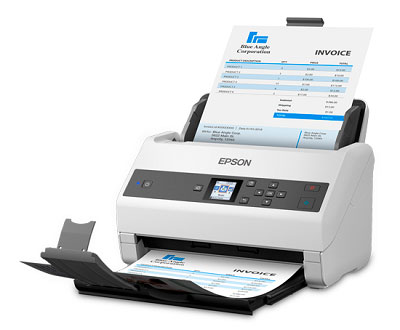Going paperless, the fully-digital office—these have been buzzy possibilities for years, but very few organizations have achieved a fully or mostly paperless office.
And yes, there are a lot of moving parts and change is hard. But in a new decade, one of the best things you can do for your organization is to cut the paper and streamline your business processes.
So below are eight tips for taking your company in a paperless direction.

1. Establish (or Enforce) File Naming Conventions
Before you do anything with software, hardware, or processes, you really need to decide what your file and naming conventions are going to be. Will you organize by department? Client name? Type of document? Year?
There isn’t a standard across industries or verticals, but generally names should be as descriptive as possible while also being as short as possible. Naming files with 20 words separated by hyphens is going to be a pain to sort through later.
Make sure that anyone who will be adding documents to your content management system or shared drive is trained in these naming conventions and file destinations.
Here are some resources for developing your naming conventions:
- File and naming convention tips from the Princeton Library
- Best practices for file naming from the Stanford Library
- File naming conventions: why you want them and how to create them
2. Stop Paper Intake with E-forms
As anyone who is in charge of onboarding employees, patients, or members can tell you, there’s a lot of paper involved with taking in new people.
But instead of printing out hundreds of copies of welcome packets or paperwork, what if you could send a new employee a link to a private website to fill out forms prior to their first day in the office? How about handing a patient a tablet to fill out their change of insurance?
allow you to do just that. You can take pretty much any paper form imaginable and convert it into an electronic form. The best part? You can set up pre-selected group of choices or ensure that a user has to fill out a box before they submit. Not only will this cut down on paper, but also on errors and precious time trying to figure out what someone’s handwriting says.
For example: one of our clients uses an e-form for healthcare open enrollment. Being able to control answers and ensure that people have to fill out all required fields has nearly eliminated the human hours needed to check and input data.
3. Start Using Digital Signatures
Hand in hand with electronic forms is electronic signatures. How many contracts or paperwork do you need to print off just so a customer or patient can sign it?
Electronic signature software allows for employees, customers, and patients to sign forms without a hard copy. No longer will you need to worry about printing out paperwork or having multiple copies floating around. Digital signatures are also easier to track for compliance or audit reasons.

4. Purchase Desktop Scanners to Digitize Incoming Paper
Another great, easy way to eliminate incoming paper is to scan documents as you receive them. This can be done on a central network scanner or personal desktop scanners. Instead of filling desk drawers and filing cabinets with paper, all of your invoices, applications, claims, and other paper documents can be scanned and filed away in your document management system or central server.
Depending on the amount of paper you need to scan every day, there are scanners that cost as low as $350, like the Epson DS-530, that can get the job done. Many come bundled with software that allow you to easily view, modify, and file away the image.
Desktop scanners offer far superior quality to just using the scan option on your multi-function printer.

5. Research and Implement a Document or Content Management System
Even if you cut down on paper with scanners and e-forms, you’re still going to need a way to manage that information. That’s where a document and/or content management system comes in.
These systems are specifically designed to store, find, and move information. A document management system is best for storing, retrieving, and sharing your scanned and electronic documents. A content management system (like Laserfiche) allows for storing all kinds of information (pictures, mp3 files, videos, digital faxes, etc. in addition to documents) and has advanced features like workflow to help speed up your business processes.
Yes, Google Docs and Microsoft SharePoint can act as central repositories for your electronic documents. But specialized document management software will allow for editing, annotating, and much more secure sharing with easy integrations into the systems you already use.
There are a lot of choices for content management, so make sure that you do your research (or consult with a firm) and think about what you want the future state of your company to look like. Picking a system with the right advanced features, even if you don’t implement them all at once, will make sure that you stay committed!
To learn more about document and content management, see our blog posts: Everything You Need to Know About Document Management and Everything You Need to Know About Content Services.
6. Let Integrations Image-Enable Your Existing Systems
One of the things that we hear frequently is that companies don’t want to change systems. And because they don’t want to change systems, they’re still doing a lot of their work on paper.
We get that! When your organization is comfortable with a system, it’s really hard to make every employee learn a new one. The good news is that you don’t necessarily have to give up the system you like so much just to go paperless.
Consultants (like us!) can write integrations between your LOB system and a basic document management system so that you can pull up documents with a hot key or click of a mouse. This means more information at your fingertips without massive retraining.
7. Consider Outsourcing Your Mailroom
Another way to cut out paper is to switch to an outsourced mailroom. By outsourcing mailroom activities, you can let another company handle your mail (physical and even electronic). They can collect it, scan it, and deliver it to the recipient or send it directly into a workflow.
So invoices? Scanned and sent to accounts payable. Insurance claims? Scanned and sent to your processing department. All of your business processes can still be carried out without your office having to see a single piece of paper.
8. Don’t Change Everything at Once
There are two approaches you can take to make this a successful transformation:
- A full overhaul with project timeline
- Incremental change where you do one thing at a time
Neither is the “right” way. It all depends on your company. If you’re a large organization with many people and applications, you’ll probably need to plan out an entire multi-year overhaul with multiple milestones.
If you’re a smaller organization with more flexibility, you may want to start with just one or two things, wait for your employees to get used to the change, and then implement another thing. For example: maybe you’ll start by buying scanners and using e-forms and then later implement robotic process automation (RPA) or start automating your AP processes.
No matter what step you take first, your organization will be well on your way to streamlining your business and cutting out the paper.
Are you looking to go paperless this year? Then we’d love to help out. Contact us or give us a call at (630) 321-0601.
Questions or comments on this article? Find us on LinkedIn or Twitter.

